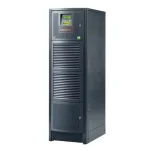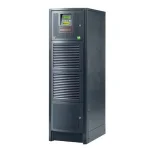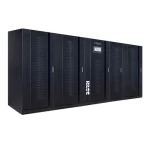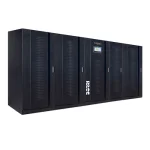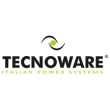Monoblock are fixed capacity uninterruptible power systems. To scale or add N+X resilience, another monoblock UPS must be installed i.e. 2 × 100kVA to give 100kV N+1 or 200kVA capacity. With a modular UPS, an additional UPS module can be added to a UPS frame to provide N+1 redundancy or increase the power capacity up to the maximum number of UPS modules that can be housed by the frame. The modular UPS system can be expanded further by adding another UPS frame.
Modular UPS
Modular UPS systems have a standard module size and a range of frame sizes into which a set number of UPS modules can be installed. The modules are typically plug and play and can be arranged in an N+X parallel or capacity arrangement. Modular UPS are very efficient with on-line operational efficiencies of 96% or more achieved using the latest power electronics and intelligent controls that place unused modules into a ‘sleep mode’. Modular UPS systems may also use plug-in battery cartridges or be connected to an external battery cabinet or battery stand arrangement.
- UPS Systems (677)
- UPS Solutions (678)
- UPS Technologies (662)
- Power Distribution (333)
- Backup Power (458)
What are Modular UPS Systems?
Modular UPS are scalable UPS systems that comprise of cabinet that is referred to as a UPS frame into which UPS modules are installed to provide an uninterruptible power array that can be arranged as N+X for redundancy or N for capacity. A modular UPS can scale vertically up to the maximum capacity rating of the UPS frame. UPS frames can be installed in parallel to provide horizontal scalability. A UPS frame may also have the capability to house slide-in battery trays. Where this is not the case, the battery is housed externally in a separate battery cabinet or on a battery stand.
What are the main features of a modular Uninterruptible Power Supply?
A modular UPS provides the capability to size the UPS system for its day one load and to be able to add additional modules as the load size increases. The UPS modules can be arranged in an N+X configuration to provide parallel/redundancy and resilience to the overall system.
In terms of static and maintenance bypass arrangements, the UPS frame will house the electrical switchgear and bypass arrangement for the complete power platform. Individual UPS modules may also incorporate their own static switches dependent upon the UPS manufacturer.
A modular back-up power UPS has a smaller footprint than a monoblock type UPS. The mean time to repair (MTTR) is lower due to the use of slide-in power modules.
Modular UPS Benefits
There are many advantages to using a modular UPS system. Automatic load right-sizing allows a modular UPS to save energy. Only the UPS modules required to support the load and maintain N+X resilience need to be powered at any one time. Any other modules built-into the UPS frame can be put into a ‘sleep mode’ to save energy. This process can be cycled over a period of time to ensure all the UPS modules are used to support the load.
Automatic load right-sizing allows a modular UPS to save energy. Only the UPS modules required to support the load and maintain N+X resilience need to be powered at any one time. Any other modules built-into the UPS frame can be put into a ‘sleep mode’ to save energy. This process can be cycled over a period of time to ensure all the UPS modules are used to support the load.
Modular UPS are scalable and allow a UPS to be right-sized for the given application on day-one and then scaled to meet future growth of the IT load. The scalability of the solution can lead to increased energy efficiency compared to a monoblock or monolith type system as the UPS can automatically adjust module usage to match the load profile. Modules can be put into ‘sleep’ mode to save energy. This can also reduce cooling load in the server room or data centre. This type of uninterruptible power supply is also easier to maintain with a higher MTTR. Modules simply be swapped out should they require this. Additional modules can be inserted into the frame using ‘hot-swap’ connections. Scalability also tends to be vertically inside the UPS frame, reducing footprint/space needs in a server room or data centre. Some modular systems (single and 3phase) are self-contained and can be inserted into an existing 19inch server rack.
Modular vs Conventional UPS
There are several differences between monoblock and a modual UPS system. A monoblock UPS is a fixed capacity system and the only way to add additional capacity is to add another UPS system of the same rating. For example, for a 100kVA monoblock UPS, an additional 100kVA UPS must be added in a parallel capacity configuration even if the only additional required capacity is 25kVA. In a modular UPS a 25kVA UPS module could be added to a 125kVA UPS frame.
| UPS Feature | Advantage of a Modular System | Disadvantage of a Conventional UPS |
|---|---|---|
| Resilience | Add a module for N+1 | Add a complete system for N+1 |
| Scalability | Add modules to the UPS Frame | Only expandable by adding another UPS System |
| Footprint | Scales vertically or horizontally | Scales horizontally only |
| Serviceability | Hot swap modules | Hardwired UPS cards |
| Battery | Plug-in modules or external cabinet | Hardwired internal battery or external cabinet |
| Efficiency | Higher – easier to right size to the load | Lower for fluctuating loads |
Modular UPS Disadvantages
It is important to size the LV switchgear supplying electrical power to the UPS for day-one and future growth. LV switchboards and building incomers are normally fixed in size and not scalable. If a the backup power supply is to be expanded with additional modules in the future, the LV supplies must be suitably rated. This also applies to the UPS frame which should be sufficiently sized to meet the future growth expansion. Modular backup power systems can therefore require more extensive project planning.
For UPS manufacturers including AEG Power Solutions, Centinel, Eaton, Huawei, Legrand, Riello UPS and Vertiv there are two primary approach to static transfer switching. The first is to have individual static switches in each UPS module and the second is to rely on UPS frame sized static transfer switch. Static switches are inherently reliable and failure under overload or fault condition is extremely rare. The former may provide slightly more resilience but at a higher cost.
Does a modular power supply use less space than a conventional UPS?
A modular UPS is typically 35-50% more space-efficient for a data centre or server room and more compact than a traditional monoblock type UPS. This is dependent upon the UPS frame size chosen initially and where the batteries are housed. Some UPS frame also have a section to house slide-in battery trays.
Modular System Specifications
UPS modules are typically rated at Unity Power Factor where kW=kVA i.e. 25kW=25kVA. Once the total load capacity (in kW) has been determined the total number of power modules can be calculated:
Load kW / UPS module size = number of UPS modules required
Additional UPS modules may then be added to achieve N+X parallel ups redundancy. The most common practice being to add one further module for N+1 redundancy.
Once the number of UPS modules has been determined the next step is to select a UPS frame size. A typical modular power systems manufacturer may offer two or three frame sizes. The frame can be fully or partly populated (with UPS modules). Best practice is to allow one to two slots (if available) for future expansion.
The modular UPS frame will incorporate the necessary electrical switchgear to connect the UPS to the local mains power supply and to connect the output from the UPS modules as a system to the connected load(s). The UPS frame should also incorporate an overall static bypass and maintenance bypass switch arrangement. These switches may also be built-into some UPS modules.
Modular uninterruptible power supplies tend to have a price premium over mono-block UPS systems including transformer-based and transformerless designs.
For individual product specifications please refer to the individual products and their specification datasheets.
Scalable and Resilient UPS
Modular uninterruptible power supplies tend to be transformerless UPS allowing the individual modules to achieve high operating efficiencies of up to 97% or more in on-line mode and up to 99% in line interactive or ‘eco’ mode. The UPS modules are designed for hot-swap and when connected into a UPS frame are automatically detected and an initialisation process started. Only if the UPS modules passes the start-up and self-test procedure is it allowed to power the critical load. This flexibility means that a modular power UPS can be ‘right sized’ for the load in operation at any given time and provide N+X resilience.
Modular Energy Efficiency
Modular UPS system architectures are based on a frame size, designed to take a maximum number of UPS modules. A site can choose to install a sufficient number of modules for the load profile or add in extra modules for N+X redundancy.
When there are more modules than are required to power the load, a modular power system can increase its operational efficiency by ‘sleeping’ redundant modules. If the mains power supply fails, all the modules in ‘sleep’ mode are activated. After the mains power supply has stabilised the energy saving process can start again, with the load shared across only those modules required to meet the load kVA/kW demands. To help prolong the working life of the UPS modules, they can be cycled by the control architecture to ensure all modules received a similar amount of time supporting the load.
The process ensure that there is always sufficient power protection for the connected loads whilst ensuring the highest levels of operating energy efficiency and therefore a lower running cost.
Modular Power System Maintenance and Service
With a modular UPS, the typical mean time to repair (MTTR) is around 30 minutes. This is due to the fact the modules can be hot-swapped whilst the UPS system is operational. A monoblock UPS may have an MTTR of around 1-2 hours in comparison depending on which assembly or PCB requires replacement. It is therefore easier to maintain and service a modular system and the service engineer’s time on site can be spent interrogating the operating logs or inspecting the battery set.
A modular system will have a similar mean time between failure (MTBF) to a monoblock transformerless UPS of around 200,000. This is the defined by the static switch arrangement which may be centralised in the UPS module frame or decentralised into each UPS module.
UPS Uptime and Resilience
Modular systems are better able to help a server room or datacentre meet the ‘high availability’ requirements of EN50600-2-2 (class 3) to achieve 99.995% (four nines) availability. This level of availability requires redundant critical power supplies, which can be more easily achieved with a modular UPS system where one additional UPS modules can provide N+1 redundancy. With a monoblock UPS, another complete uninterruptible power supply must be installed in parallel to the original one to provide N+1 redundancy. This is not only more costly in terms of capital investment but installation and running costs.
UPS Modular Battery Packs
There are two types of battery set arrangements for a modular UPS system. The first is a traditional valve-regulated lead acid (VRLA) battery set and the second is a lithium-ion set of batteries. Lead acid battery technology has been the standard type used in uninterruptible power supply installations. The batteries are available with 5-year and 10-year design lives with replacement typically taking place within years 3-4 and 7-8 respectively. Lead acid battery technology is particularly suited to standby power applications including modular UPS. A typical lead acid battery set will recharge to 80% within 24hours.
Lithium-ion or Li-ion batteries have a longer design life of 10-15 years are becoming a popular alternative to lead acid. Though a lithium battery set will have a 20% plus price premium over lead acid, the price has to be off-set over the working life of the battery and the ability of lithium-ion to support more frequent charge/discharge cycles. A lithium-ion battery can recharge to 80% capacity within 2-3 hours. Lithium-ion batteries.
For datacenter ups systems applications in particular, lithium-ion batteries can provide several benefits in addition to faster recharge times. Compared to lead acid UPS batteries, lithium batteries re around 30% more compact, leading to a small footprint for a comparable modular UPS and battery set.
Lithium batteries are also more heat tolerant. A lead acid battery has to have an ambient environment of 20-25⁰C. For every 1degree rise above 30⁰C the design life halves. Lithium batteries are tolerant and can withstand higher ambient temperatures (as can the electronics used within a modular UPS) leading to lower cooling loads.
Most modern modular UPS systems incorporate firmware settings for their charging assemblies to accommodate lead acid and lithium batteries. The configuration may also be a factory build option.
Modular type UPS battery sets can consist of either battery technology and be installed as plug-in battery cartridges or in external battery cabinets or cladded or open battery stands. The physical installation options available are brand and UPS range specific.
Modular scalable UPS solutions are available in 3phase and single phase UPS formats.
For more information on our scalable UPS modular systems please contact our projects team.

Earn SRE points on all online purchases with double points on selected products





























